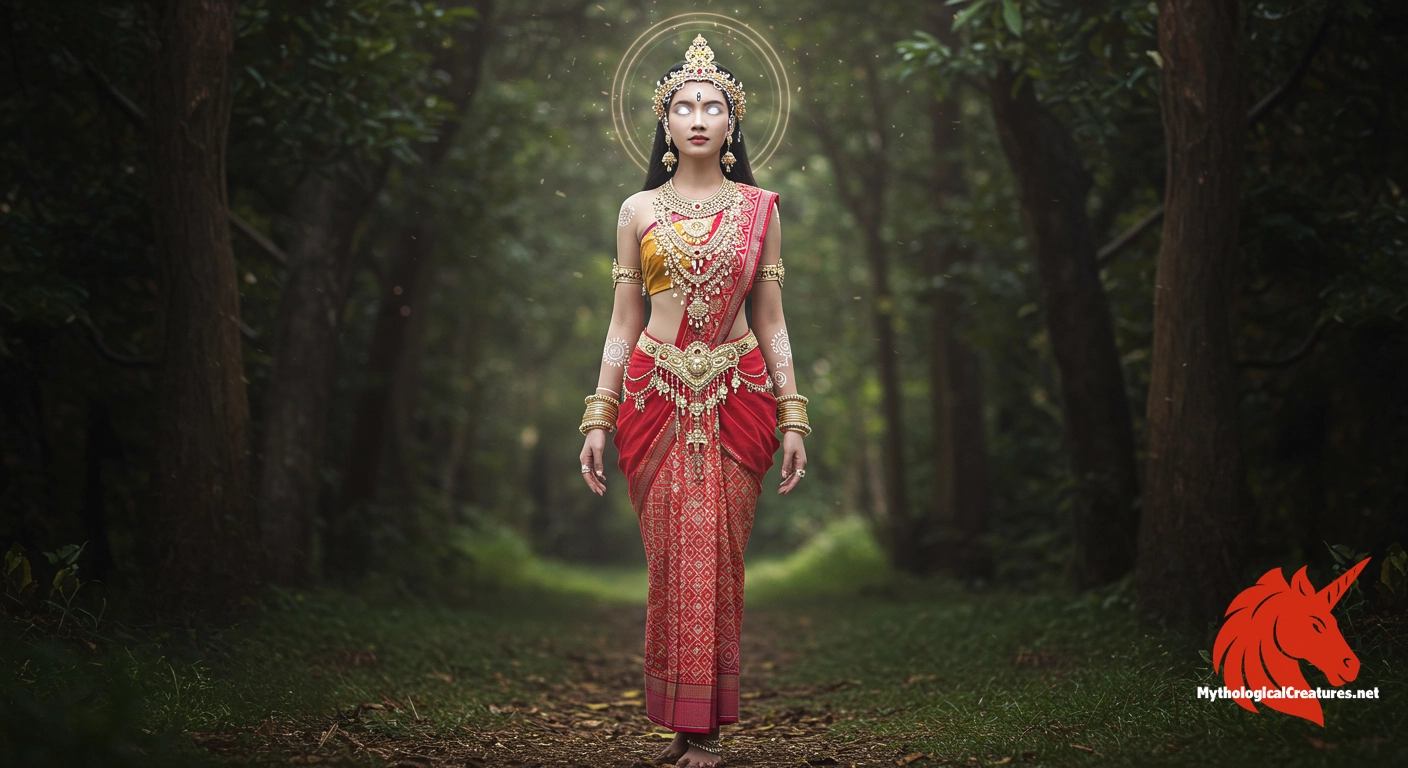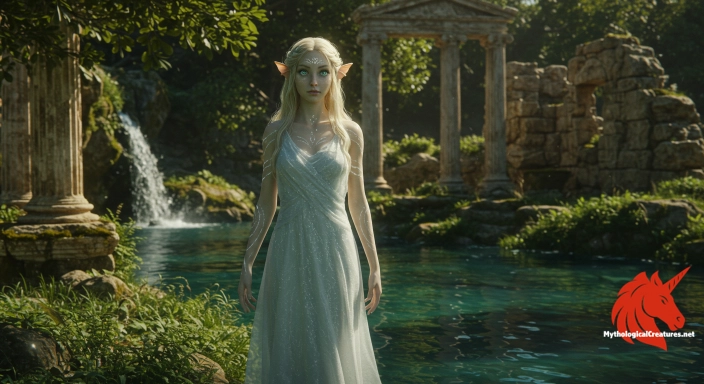Koujeng Leima: Koujeng Leima is a goddess in Sanamahism, originating from a tribal woman who was later deified by the Meitei people.

Koujeng Leima
Koujeng Leima - She represents the transformation of a tribal woman into a revered goddess and is celebrated as one of the nine laibenthous.
Origins & First Encounters
Koujeng Leima stands as a captivating figure within the diverse pantheon of Sanamahism, the indigenous religion of Manipur. Born from the rich tapestry of tribal heritage, she transformed from a mortal tribal woman into a venerated goddess. Her deification mirrors the unique cultural synthesis experienced by the Meitei people as they integrated local traditions with emerging spiritual beliefs. As the consort of God Koupalu, her divine marriage represents a harmonious union of celestial forces and earthly origins. She is celebrated not only for her marital bond but also for her participation in the revered festival of God Thangjing, where she is counted among the nine esteemed laibenthous. The legend of Koujeng Leima has been passed down through generations, reminding devotees of the transformative power of faith and the sanctity of humble beginnings. Her story resonated deeply within the communities of Manipur, symbolising hope, renewal, and the enduring nature of cultural identity. Over time, her narrative has woven itself into the collective memory of her people, standing as a testimony to the enduring legacy of indigenous spiritual traditions.
Source Texts & Tale Variants
The lore surrounding Koujeng Leima is preserved in a blend of ancient oral traditions and regional manuscript texts that embody the spirit of Sanamahism. Narratives of her life are recounted in local folklore and ritual performances, which convey both the mystery and the sanctity of her transformation. References to her story appear in traditional religious songs and hymns, where she is celebrated alongside other divine figures in seasonal festivals. Multiple versions of her tale have emerged over the years, each reflecting the nuanced beliefs and practices of distinct communities within Manipur. The festival of God Thangjing, in which she is an integral presence, serves as a living archive of her myth. Some accounts trace her origins directly to local tribal histories, while others interlace her identity with broader cosmic symbolism. The multiplicity of sources enriches our understanding, offering insights into both her divine attributes and her mortal beginnings. Despite variations in the narrative, each version contributes to a composite image of Koujeng Leima that is both historically significant and spiritually inspiring.
Form & Powers
In artistic depictions, Koujeng Leima is often portrayed with an elegant and serene demeanour that reflects her dual origins as a tribal woman and a divine statue of grace. Her visage is typically rendered with soft, inquisitive eyes and a calm expression, evoking both compassion and strength. Traditional iconography might illustrate her wearing richly embroidered garments, blending local textile patterns with symbols of fertility and abundance. Adornments such as intricate jewellery and radiant headpieces further accentuate her elevated status among the deities of Sanamahism. The imagery associated with her often includes elements of nature, such as blooming flowers or flowing water, hinting at her role in nurturing life and prosperity. Some depictions also incorporate subtle hints of traditional tribal motifs, signifying her roots in the indigenous communities of Manipur. The size and scale of her representations may vary, with smaller figurines used in household shrines and grander statues adorning temple altars. Each visual portrayal reinforces her connection to both the earthly and the ethereal realms.
Regional Faces
The character of Koujeng Leima takes on diverse shades depending on the region within Manipur and nearby locales where her worship is practised. In some communities, she is revered primarily as a nurturing figure who safeguards the natural bounty and communal traditions. Rural areas sometimes highlight her origins as a tribal woman, celebrating her metamorphosis into a divine guardian through local festivals and village rituals. Urban interpretations, on the other hand, may focus more on her divine role as the consort of God Koupalu and her contributions to religious ceremonies. Variations in her iconography can be observed, with some regions favouring more ornate depictions that emphasise her royal aura, while others adopt simpler, earthy portrayals. The festivals dedicated to her are imbued with regional musical traditions, dance, and ritualistic performances that underscore her multifaceted nature. Local adaptations of her myth underscore the resilience and adaptability of indigenous belief systems. Across regions, these diverse representations highlight a vibrant cultural dialogue that sustains her relevance in contemporary spiritual practices.
Cultural Parallels
The narrative of Koujeng Leima finds parallels in numerous other cultural traditions where a mortal figure is elevated to divine status. Her transformation mirrors similar themes found in other indigenous cultures of South Asia and Southeast Asia, where individuals are sanctified through repeated ritual and communal adoration. Like several local goddesses, she embodies the fluid boundary between the human and the divine, a motif also seen in the deification of revered ancestral figures elsewhere. Comparative mythology often reveals these intersections, where themes of transformation and divine marriage create a tapestry of interlinked stories. Her story also resonates with broader cultural depictions of feminine power and resilience, a common thread running through many mythological narratives across the region. The union with God Koupalu additionally draws comparisons with other celestial couples whose partnerships symbolise harmony between different realms. While her attributes are distinct, the shared motif of human-to-divine transformation can be observed in diverse traditions ranging from tribal communities to more mainstream religious narratives. These cultural parallels enrich our understanding of Koujeng Leima as part of a wider phenomenon that celebrates the sanctity of transformative life journeys.
Legacy & Modern Evolution
Over the centuries, the depiction of Koujeng Leima has evolved from a locally revered tribal figure to a goddess with an expansive cultural legacy. Early accounts of her persona have been transformed by successive generations of devotees, each adding layers of interpretation reflective of their own societal values and aesthetic sensibilities. In modern times, she remains an emblem of indigenous pride and the enduring power of local traditions amidst rapid cultural change. Contemporary festivals continue to celebrate her spirit, blending age-old rituals with modern artistic expressions in dance, music, and visual art. This evolution underscores a dynamic relationship between tradition and modernity, where ancient deities are reimagined for new audiences. Her story is often invoked in discussions about cultural reconciliation and the revival of indigenous practices in a rapidly globalising world. New scholarly interest has led to a resurgence of research and artistic renderings that ensure her myth is not lost to time. Today, Koujeng Leima stands not only as a religious symbol but also as a cultural beacon, inspiring communities to reconnect with their ancestral roots and celebrate the richness of their heritage.
Interesting Fact
An interesting facet of Koujeng Leima's mythology is her evolution from a common tribal woman into a powerful goddess, reflecting the fluid boundaries between mortality and divinity in Meitei culture.
Quick Creature Info
Our Mythic Legendary Rating:

Also Sometimes Known As:
Habitat:
Supernatural Powers:
Physical Attributes:
Abilities:
Behavior:
Lore:
Related Creatures, Tales or Lore
References
Discover Another Mythical Legend You May Not Have Heard Of?
Uncover the mysteries of ancient folklore and expand your knowledge of legendary beings from cultures around the world.
Dare to Meet the Periboea....
Curated by the Mythological Creatures Team (rev. May 2025)
